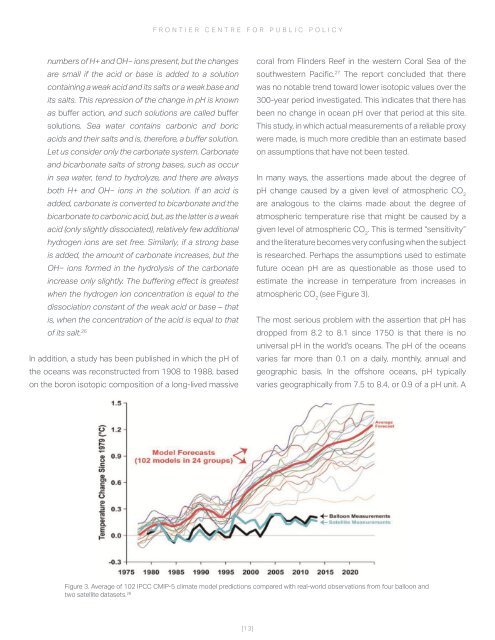OCEAN “ACIDIFICATION” ALARMISM IN PERSPECTIVE
rUUhYH
rUUhYH
You also want an ePaper? Increase the reach of your titles
YUMPU automatically turns print PDFs into web optimized ePapers that Google loves.
FRONTIER CENTRE FOR PUBLIC POLICY<br />
numbers of H+ and OH− ions present, but the changes<br />
are small if the acid or base is added to a solution<br />
containing a weak acid and its salts or a weak base and<br />
its salts. This repression of the change in pH is known<br />
as buffer action, and such solutions are called buffer<br />
solutions. Sea water contains carbonic and boric<br />
acids and their salts and is, therefore, a buffer solution.<br />
Let us consider only the carbonate system. Carbonate<br />
and bicarbonate salts of strong bases, such as occur<br />
in sea water, tend to hydrolyze, and there are always<br />
both H+ and OH− ions in the solution. If an acid is<br />
added, carbonate is converted to bicarbonate and the<br />
bicarbonate to carbonic acid, but, as the latter is a weak<br />
acid (only slightly dissociated), relatively few additional<br />
hydrogen ions are set free. Similarly, if a strong base<br />
is added, the amount of carbonate increases, but the<br />
OH− ions formed in the hydrolysis of the carbonate<br />
increase only slightly. The buffering effect is greatest<br />
when the hydrogen ion concentration is equal to the<br />
dissociation constant of the weak acid or base – that<br />
is, when the concentration of the acid is equal to that<br />
of its salt. 26<br />
In addition, a study has been published in which the pH of<br />
the oceans was reconstructed from 1908 to 1988, based<br />
on the boron isotopic composition of a long-lived massive<br />
coral from Flinders Reef in the western Coral Sea of the<br />
southwestern Pacific. 27 The report concluded that there<br />
was no notable trend toward lower isotopic values over the<br />
300-year period investigated. This indicates that there has<br />
been no change in ocean pH over that period at this site.<br />
This study, in which actual measurements of a reliable proxy<br />
were made, is much more credible than an estimate based<br />
on assumptions that have not been tested.<br />
In many ways, the assertions made about the degree of<br />
pH change caused by a given level of atmospheric CO 2<br />
are analogous to the claims made about the degree of<br />
atmospheric temperature rise that might be caused by a<br />
given level of atmospheric CO 2<br />
. This is termed “sensitivity”<br />
and the literature becomes very confusing when the subject<br />
is researched. Perhaps the assumptions used to estimate<br />
future ocean pH are as questionable as those used to<br />
estimate the increase in temperature from increases in<br />
atmospheric CO 2<br />
(see Figure 3).<br />
The most serious problem with the assertion that pH has<br />
dropped from 8.2 to 8.1 since 1750 is that there is no<br />
universal pH in the world’s oceans. The pH of the oceans<br />
varies far more than 0.1 on a daily, monthly, annual and<br />
geographic basis. In the offshore oceans, pH typically<br />
varies geographically from 7.5 to 8.4, or 0.9 of a pH unit. A<br />
Figure 3. Average of 102 IPCC CMIP-5 climate model predictions compared with real-world observations from four balloon and<br />
two satellite datasets. 28<br />
[13]


